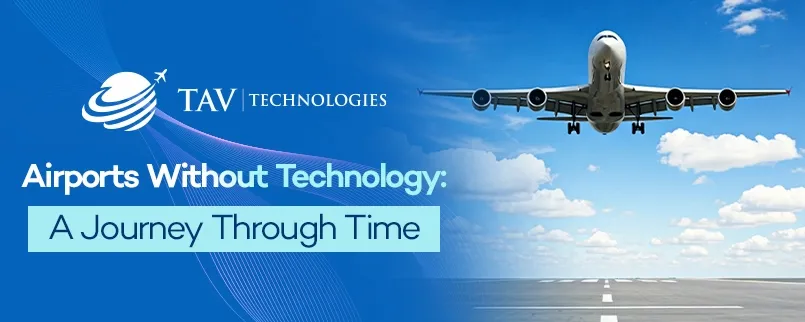
Sep 2024
Imagine stepping into an airport without technology—no digital screens flashing flight times, no automated check-ins, and no GPS tracking your flight's route. Instead, you're handed a paper ticket, check-in is manual and tedious, and all flight communications are relayed by word of mouth or handwritten notes. While this may seem like a distant and almost unimaginable past, there was indeed a time when airports functioned without the advanced technologies we take for granted today.
The Early Days of Aviation
In the early 20th century, airports were far from the sprawling, high-tech hubs we know today. The first "airport" was little more than a patch of land with a hangar to store the planes. Flights were infrequent and catered to a small number of passengers, often the wealthy elite. The first commercial flight occurred in 1914 between St. Petersburg and Tampa, Florida. It was an open-air journey with a single passenger aboard. There were no boarding passes, security checks, or information displays. Instead, passengers relied on a schedule posted on a bulletin board and verbal announcements from staff.
As air travel became more popular, airports began to expand. But everything was done manually—pilots navigated using maps and visual landmarks, passengers checked in at desks with handwritten logs, and flight updates were passed along through word of mouth. If a flight was delayed, travelers were often left in the dark until they could speak to an airline employee.
Airports Without Technology: A Chaotic Reality
Let's paint a picture of what a modern airport might look like if we stripped away today's technology:
- Manual Ticketing and Check-in: Without online booking systems, you'd have to purchase tickets in person at a travel agency or directly from the airline. Long lines would form at ticket counters, with agents manually entering passenger details into thick logbooks. Checking in would involve waiting for your name to be called as staff shuffled through papers to assign seats and issue paper boarding passes.
- No Baggage Tracking: Today, airlines use barcodes and tracking systems like TAV Technologies Baggage Reconciliation System to ensure luggage gets to the right destination. Without technology, lost luggage would be much more common. Airline staff would have to sort and track bags by hand, with tags handwritten and prone to error.
- No Digital Flight Information: Picture a giant chalkboard in the center of the airport, with staff periodically erasing and updating flight information. Flight delays would be announced over crackly loudspeakers, and passengers would constantly need to check with the staff to stay updated on their departure times without the Flight Information Display System.
- Navigation and Air Traffic Control: Without radar and GPS systems, pilots would have to rely on visual cues, maps, and compasses to navigate. Air traffic control would be done via radio, with no centralized real-time system to track multiple aircraft. This would dramatically increase the risk of mid-air collisions, missed landings, and flight route inefficiencies.
- No Security Scanners: Airports rely heavily on technology for safety. Security would be significantly less efficient and far more vulnerable without scanners, X-rays, and automated identification systems. Each bag would have to be manually searched, making lines extremely long, and the potential for threats would be much higher.
- Weather Updates and Safety: Today’s pilots rely on real-time weather data to ensure a safe flight. Without technology, they would depend solely on surface-level observations or outdated reports. Turbulence, storms, and unexpected weather events would make air travel more unpredictable.
The Technological Revolution: Changing the Way We Fly
The advent of technology in airports began with simple innovations and quickly advanced to what we now see as indispensable systems. Some of the most significant advancements that transformed air travel include:
- Radar and Air Traffic Control Systems: Developed during World War II, radar systems allowed for the real-time tracking of planes.
- Digital Flight Management Systems: Computers onboard aircraft allow pilots to input routes, altitudes, and speed profiles, automating much of the flight planning process.
- Online Booking and E-Tickets: The introduction of online booking systems in the 1990s changed how people purchased tickets.
- Baggage Handling and Tracking: Airports can now track every piece of luggage as it moves through the system by implementing barcode systems and RFID (Radio Frequency Identification) tags.
- Biometrics and Security: Advanced security technologies such as biometric scanners (using fingerprints and facial recognition) have made airports safer and streamlined passenger processing.
- Passenger Information Systems: Digital screens, apps, and automated announcements.
The Critical Role of Technology in Modern Airports
It’s hard to imagine modern air travel without the aid of technology. The advancements in automation, communication, navigation, and safety have made air travel more efficient, accessible, and secure. Without these innovations, airports would be chaotic, inefficient, and unsafe, ultimately making air travel less convenient and more daunting for passengers. Technology has revolutionized the aviation industry, transforming airports from simple airfields to complex and efficient hubs connecting millions of people worldwide every day.
